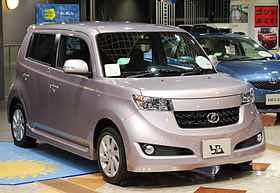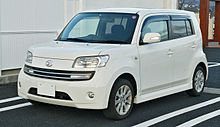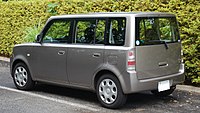Toyota bB
This article needs additional citations for verification. (December 2018) |
| Toyota bB | |
|---|---|
 Second generation Toyota bB (2008) | |
| Overview | |
| Manufacturer | Toyota |
| Also called |
|
| Production | January 2000 – May 2016 |
| Body and chassis | |
| Class | Mini MPV |
| Body style |
|
| Layout | Front-engine, front-wheel-drive |
| Chronology | |
| Predecessor |
|
| Successor |
|
The Toyota bB is a mini MPV produced by the Japanese car company Toyota. The first generation launched in 2000, and the second generation was jointly developed with Daihatsu from 2005.
The car has been badge engineered and sold as the Daihatsu Materia, Scion xB and Subaru Dex.
First generation (XP30; 2000)[edit]
| First generation (XP30) | |
|---|---|
 | |
| Overview | |
| Also called | Scion xB (North America) |
| Production | January 2000 – December 2005[1][2] |
| Assembly | Japan: Toyota, Aichi (Takaoka plant)[1] |
| Body and chassis | |
| Body style | 5-door hatchback |
| Platform | Toyota NBC platform |
| Related | |
| Powertrain | |
| Engine | |
| Transmission | 4-speed automatic |
| Dimensions | |
| Wheelbase | 2,500 mm (98.4 in) |
| Length | 3,825–3,945 mm (150.6–155.3 in) |
| Width | 1,690 mm (66.5 in) |
| Height | 1,640–1,695 mm (64.6–66.7 in) |
| Curb weight | 1,070–1,130 kg (2,359–2,491 lb) |
The first generation bB was based on the Toyota Vitz and the development was led by Toyota chief engineer Tetsuya Tada.[3] While the box-shaped mini MPV was initially targeted towards Japanese men in their twenties, it is also popular with women buyers.[citation needed]
Production of the bB occurred between January 2000 and April 2005 at the Takaoka plant in Toyota, Aichi.[1] Production occurred at the former Central Motors between August 2004 and December 2005 for the bB; export Scion xB model continued until December 2006.[2] In more recent years, the first and second-generation bB have been at least privately imported to the United Kingdom, the Republic of Ireland, Australia and New Zealand.
Engines[edit]
Engine choices include 1.3- and 1.5-litre inline-four engines.
The Scion xB (XP30) came standard with the 1.5 litre inline-four engines.
Marketing[edit]
In the United States, the first generation bB was sold under the Scion brand as the xB from June 2003 to 2007.
For the Scion xB, the front passenger area was also changed significantly with the bB's front bench seat replaced with bucket seats and the column-mounted shifter changed to a floor-mounted shifter.
Open Deck (2000–2001)[edit]
The bB Open Deck was a coupe utility version of the bB.
Gallery[edit]
-
Japanese spec bB
-
North American spec xB
-
xB Release Series 1.0 variant
-
bB Open Deck
Second generation (QNC20; 2005)[edit]
| Second generation (QNC20) | |
|---|---|
 | |
| Overview | |
| Also called |
|
| Production |
|
| Assembly | Japan: Ikeda, Osaka (Daihatsu Head Plant) |
| Designer | |
| Body and chassis | |
| Body style | 5-door hatchback |
| Related | |
| Powertrain | |
| Engine | |
| Transmission | 5-speed manual 4-speed automatic |
| Dimensions | |
| Wheelbase | 2,540 mm (100.0 in) |
| Length | 3,785–3,800 mm (149.0–149.6 in) |
| Width | 1,690 mm (66.5 in) |
| Height | 1,635 mm (64.4 in) |
| Curb weight | 1,040–1,120 kg (2,293–2,469 lb) |
The second generation bB was unveiled at the 2005 Tokyo Motor Show. Production version went on sale in Netz dealers. The second generation Scion xB is not based on the bB, but was specifically designed by Toyota to appeal to American buyers, which was sold in Japan as the Toyota Corolla Rumion. Badge engineered Daihatsu and Subaru models were also produced, but production ceased in 2012, leaving just the Toyota model. Production of the Toyota model also ceased in May 2016, with sales ending in Japan in July 2016, and it was replaced by the Toyota Tank and its twin counterpart the Toyota Roomy, which is a rebadged Daihatsu Thor.
Design[edit]
The vehicle was designed as "A Car-shaped Music Player" to hopefully satisfy the preferences of the younger generation. The Daihatsu version can be identified by a wider and shallower grille and indicator layout.
Body styles[edit]
| Chassis codes | (DBA-)QNC21-BHSGK | (DBA-)QNC25-BHSGK | (DBA-)QNC20-BHSXK | (DBA-)QNC25-BHSXK |
|---|---|---|---|---|
| Model | Z 1.5 2WD | Z 1.3 4WD | S 1.3 2WD | S 1.3 4WD |
| Drive | FWD | 4WD | FWD | 4WD |
| Engine | 3SZ-VE | K3-VE | K3-VE | K3-VE |
Engines[edit]
| Code | Type/code | Power, torque@rpm |
|---|---|---|
| 3SZ-VE | 1,495 cc (1.5 L; 91.2 cu in) (72.0 mm x 91.8 mm) I4 | 109 PS (80 kW; 108 hp) @6000, 141 N⋅m (104 lb⋅ft) @4400 |
| "3SZ-VET" (South Africa)[7] | 1,495 cc (1.5 L; 91.2 cu in) (72.0 mm x 91.8 mm) I4 | 150 PS (110 kW; 150 hp) @5750, 190 N⋅m (140 lb⋅ft) @4800 |
| K3-VE | 1,297 cc (1.3 L; 79.1 cu in) (72.0 mm x 79.7 mm) I4 | 92 PS (68 kW; 91 hp) @6000, 123 N⋅m (91 lb⋅ft) @4400 |
Transmissions[edit]
All Toyota models include Super ECT 4-speed automatic transmission.
Daihatsu Coo/Materia[edit]

The Daihatsu Materia (Daihatsu Coo in Japan) replaced the Daihatsu YRV and is largely identical to the second generation of the Toyota bB. It came in 1.3-litre and 1.5-litre varieties with a 4WD option that was available in Japan and several European markets. There were manual and automatic gearbox options. 0–97 km/h (0–60 mph) times are 10.8 seconds for the manual and 13.7 seconds for the auto. The maximum speed is 171 km/h (106 mph) for the manual and 164 km/h (102 mph) for the automatic.
In the tenth series of Top Gear, Jeremy Clarkson jokingly compared the Materia to the Ascari A10, saying, "Sure the Daihatsu Materia is a good car... but on balance... I'd choose the big, yellow, shouty car instead."[8]
The Daihatsu Materia was only ever available with a 1.5-litre, 16 valve, fuel injected, petrol engine in the UK market.[9]
A limited edition Daihatsu Materia Turbo version was available only for the South African market.[7]
The vehicles were built in Head (Ikeda) Plant, Daihatsu Motor Co., Ltd.[10]
Sales of the Daihatsu Coo ended in Japan in January 2013.
Subaru Dex[edit]
The Subaru Dex is a badge engineered version for Subaru with the K3-VE 1.3-litre engine and a choice of FWD or 4WD.
Gallery[edit]
-
2005 Toyota bB (Japan)
-
2008 Toyota bB Aero Package (Japan)
-
2008 Toyota bB (Japan)
-
2008 Subaru Dex (Japan)
-
Daihatsu Materia
-
Daihatsu Materia
References[edit]
- ^ a b c "Takaoka Plant". Toyota Motor Corporation. 2012. Retrieved 2014-07-21.
- ^ a b "Affiliates (Toyota wholly-owned subsidiaries)-Toyota Motor East Japan, Inc". Toyota Motor Corporation. 2012. Retrieved 2014-07-21.
- ^ O'Kane, Tony (2018-08-28). "Tetsuya Tada: meet the hero behind the Toyota Supra". Which Car. Australia. Retrieved 2019-07-14.
- ^ "A00200600964". DGIP.go.id. Pangkalan Data Kekayaan Intelektual. 2006-05-12. Retrieved 2022-06-11.
- ^ "Mark Widjaja, Mobil dengan Simple Design Tak Pernah Usang" [Mark Widjaja: A Car with Simple Design Never Gets Old]. Otomotif (in Indonesian). Indonesia. 2011-09-13. Retrieved 2019-07-14.
- ^ "Sttt.. Desainer Ayla Pernah Tak Naik Kelas" [Ayla's Designer Had Used to Failed Grades]. Okezone (in Indonesian). Indonesia. 2012-11-06. Retrieved 2019-07-15.
- ^ a b c "Materia Turbo finally here". www.wheels24.co.za. 2009-11-13.
- ^ Top Gear, Series 10, Episode 9.
- ^ "Daihatsu Materia owners' reviews, problems and advice". Parkers. UK. Archived from the original on 2011-09-09.
- ^ "Toyota Launches Fully Redesigned bB — "A Car-shaped Music Player" that Incorporates Youthful Sensibilities —". Toyota Japan. 2005-12-26. Archived from the original on 2012-02-22. Retrieved 2012-05-05.










